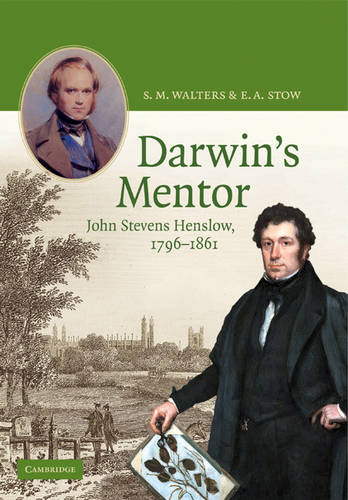
(1796–1861)
I fully believe a better man never walked this earth.
Charles Darwin to J.D. Hooker
18th May, 1861
If anyone could lay claim to being one of the greatest Friends of Charles Darwin, it was the Reverend Professor John Stevens Henslow. Not only did this good-natured academic and clergyman teach Darwin much of his scientific technique, but he also arranged a place for his favourite pupil aboard HMS Beagle. The rest, as they say, is history.
Teacher
In his autobiography, written towards the end of his life, Darwin described his friendship with Henslow as the most important circumstance in his whole career. Their friendship began in 1828 at Cambridge University, where Henslow was the popular Regius Professor of Botany. Darwin, an undergraduate at the university, had heard of Henslow’s brilliance from his brother, Erasmus, who revered the professor as a man who knew every branch of science. Although he was supposed to be studying for an arts degree in Theology, Euclid, and the Classics, Darwin soon secured an invitation to attend one of Henslow’s scientific soirées. In no time at all, he was a regular visitor at Henslow’s house, rubbing shoulders with fellow undergraduates and more senior members of the university’s scientific community, including the Reverend Professors Adam Sedgwick and William Whewell.
Henslow’s popularity as a teacher was due largely to his progressive teaching techniques, which relied heavily on field- and garden-work, and on encouraging his students to make observations of their own, rather than simply having them spoon-fed. Darwin attended Henslow’s field trips assiduously, and was soon taking long, almost daily walks with his tutor. Indeed, Darwin was to become such a regular companion of the professor that some of the university’s other dons began to refer to him as the man who walks with Henslow.
After Darwin had completed his final examination in 1831, Henslow persuaded him to begin studying geology, and made arrangements for him to accompany Adam Sedgwick on a geological trip to North Wales. Little did any of them realise just how soon Darwin would be putting his new geological training to the test.
Travel Agent
While Darwin was traipsing around Wales, Henslow received a letter telling him that Captain Robert FitzRoy was once again looking for a gentleman companion on a planned two-year trip to survey South America aboard HMS Beagle. Henslow had previously been offered the post, but had been dissuaded from accepting by his wife. The place had then been offered to Henslow’s brother-in-law, Leonard Jenyns, who had initially accepted the offer, but had changed his mind at very short notice.
Perceiving a perfect opportunity for his protégé, Henslow immediately dashed off a letter to FitzRoy, saying he knew the ideal man for the job. Almost as an afterthought, he also wrote to Darwin to ask him if he wanted it.
Darwin eventually managed to persuade his father that he should be allowed to go on the voyage, and, a few short months later, he set sail for South America—the first leg of what turned out to be a nearly five-year circumnavigation of the world.
Publicist
During the Beagle voyage, Darwin and Henslow corresponded as often as the primitive postal system would allow. Henslow became the main recipient of Darwin’s massive collection of scientific samples, despatched home at irregular intervals during the voyage. He saw to it that these samples were passed on to the appropriate experts for analysis, and took it upon himself to publish extracts of Darwin’s letters in respectable scientific journals.
By the time Darwin returned home in 1836, his scientific credentials and future scientific career were assured—largely thanks to Henslow.
Rector
The year following Darwin’s return to England, Henslow secured the rectorship of the neglected parish of Hitcham in Suffolk, where we was to remain for the rest of his life.
Surprisingly perhaps, the great university lecturer made only a mediocre preacher. His first congregation in Hitcham Church was not big enough to fill a single pew. He decided to concentrate, therefore, on improving the well-being of his parisioners through scientific, rather than spiritual, enlightenment. He encouraged local farmers to take part in experiments into crop diseases and fertilisers (derived from coprolites!). Indeed, two farmers he met while on holiday in Felixtowe were so impressed with his advice that they set up their own fertiliser company: Fisons. He founded a village school (giving some of the lessons himself) and the Ipswich Museum, administered local charities, introduced garden allotments for parisioners, and organised educational excursions to various venues, including the 1851 Great Exhibition.
National Figure
Henslow’s activities did not, however, become entirely parochial: he still found time to carry out archaeological excavations, tutor Queen Victoria’s children, and keep in touch with the wider scientific community, including his celebrated former pupil, Mr Charles Darwin, Fellow of the Royal Society.
Indeed, in 1860, the year before his death, Henslow chaired the legendary Oxford meeting of the British Association for the Advancement of Science, in which Thomas Henry Huxley and Henslow’s son-in-law, Joseph Dalton Hooker, crossed swords with Bishop ‘Soapy Sam’ Wilberforce over the subject of Darwin’s On the Origin of Species.
Death
The following winter, Henslow became seriously ill with a heart condition. His health continued to grow worse. Realising that the end was near, with Hooker standing vigil, he bade farewell to numerous visitors who had been called to his bedside. Conspicuous by his absence was Charles Darwin: a virtual invalid himself, Darwin did not feel well enough to make the journey to Hitcham, wretched though the decision made him feel. Had the tables been turned, one suspects that Darwin’s old tutor would surely have made the effort.
Henslow died after a bronchial attack on 18th May, 1861. Shortly afterwards, his brother-in-law, Leonard Jenyns, edited a tribute entitled Memoir of the Rev. John Stevens Henslow, to which Darwin contributed a chapter.
Further Reading
Darwin’s Mentor: John Stevens Henslow 1796–1861
by SM Walters & EA Stow.


Leave a Reply to Heather Kiegel Cancel reply